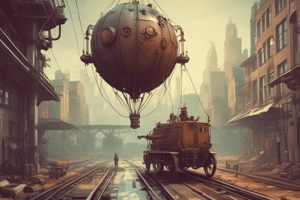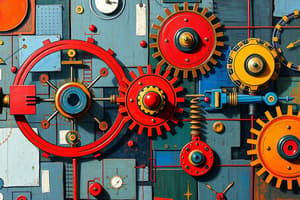Podcast
Questions and Answers
A lever creates a turning force at the fulcrum when a force is applied to one end.
A lever creates a turning force at the fulcrum when a force is applied to one end.
True (A)
A pulley can only lift objects by applying force from above.
A pulley can only lift objects by applying force from above.
False (B)
The wheel and axle are considered one type of simple machine that rotates around a central rod.
The wheel and axle are considered one type of simple machine that rotates around a central rod.
True (A)
An inclined plane can be used to elevate objects from a lower level to a higher level.
An inclined plane can be used to elevate objects from a lower level to a higher level.
A wedge has two unsharpened ends and is used to hold things together.
A wedge has two unsharpened ends and is used to hold things together.
A screw is essentially an inclined plane wrapped around a heavy cylindrical object.
A screw is essentially an inclined plane wrapped around a heavy cylindrical object.
The mechanical advantage of a machine refers to the smaller output force it provides.
The mechanical advantage of a machine refers to the smaller output force it provides.
Examples of a lever include a seesaw, crowbar, and scissors.
Examples of a lever include a seesaw, crowbar, and scissors.
Flashcards
Lever
Lever
A rigid bar that rests on a pivot point called the fulcrum. Applying a force to one end of the lever creates a turning force at the fulcrum.
Wheel and Axle
Wheel and Axle
A wheel that rotates around a central rod (the axle). A force applied to the wheel causes it to rotate, moving an object.
Pulley
Pulley
A wheel with a groove that holds a rope or cable. Pulling on one side of the rope raises an object attached on the other end.
Inclined Plane
Inclined Plane
Signup and view all the flashcards
Wedge
Wedge
Signup and view all the flashcards
Screw
Screw
Signup and view all the flashcards
Mechanical Advantage
Mechanical Advantage
Signup and view all the flashcards
Simple Machines
Simple Machines
Signup and view all the flashcards
Study Notes
Simple Machines
-
Lever: A rigid bar resting on a pivot point (fulcrum). Applying force to one end creates a turning force.
-
Examples: See-saw, crowbar, scissors
-
Wheel and Axle: A wheel rotating around a central rod (axle). Applying force to the wheel causes rotation.
-
Examples: Door knob, bicycle wheel
-
Pulley: A wheel with a groove that holds a rope or cable. Pulling on the rope changes the direction or magnitude of applied force.
-
Examples: Lifting hills
-
Inclined Plane: A flat surface at an angle. It reduces the force needed to move an object between different heights.
-
Examples: Ramps, stairs
-
Wedge: A triangular object used to split or separate objects. A wedge's thick end is its base, the pointed end is the tip.
-
Examples: Knives, axes, doorstops
-
Screw: An inclined plane wrapped around a cylinder or cone. Used to hold things together or lift heavy loads.
-
Examples: Lightbulbs, jars, and drills
Mechanical Advantage
- Mechanical advantage describes how a machine multiplies force.
- A machine with a mechanical advantage of 25 means that 1 unit of input force results in 25 units of output force.
Classes of Levers
- Class 1 Lever: The fulcrum is between the effort and the load. Effort and load can be interchanged.
- Class 2 Lever: The load is between the fulcrum and the effort. An example is a wheelbarrow.
- Class 3 Lever: The effort is between the fulcrum and the load. Muscles in the body use this type.
Studying That Suits You
Use AI to generate personalized quizzes and flashcards to suit your learning preferences.




